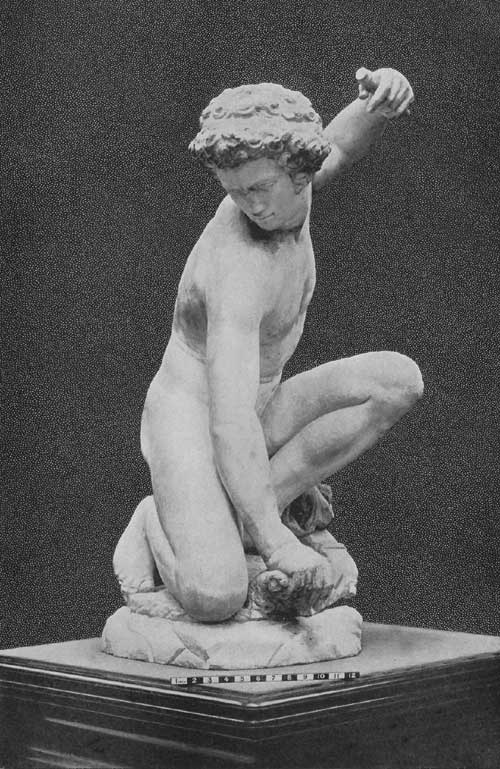III
CUPID
In the mythology of ancient Greece there is no more popular figure than the little god of love, Eros, more commonly known by the Latin name Cupid. He was supposed to be the son of Venus, the goddess of love and beauty, whom he attended. He was never without his bow and quiver of arrows. Whoever was hit by one of his magic darts straightway fell in love. The wound was at once a pain and a delight. Some traditions say that he shot blindfolded,—his aim seemed often so at random. Sometimes the one whom he wounded was apparently least susceptible to love. Indeed, Cupid had the reputation of being rather a mischievous fellow, fond of pranks.
One of these was at the expense of Apollo, the great sun god. Apollo was himself a mighty archer, and had slain with his arrows the python of Delphi. Proud of his victory, he mocked at the little god of love, advising him to leave his arrows for the warlike, and content himself with the torch of love. Cupid, vexed at the taunt, replied threateningly, “Thine arrows may strike all things else, Apollo, but mine shall strike thee.” So saying he drew from his quiver two arrows, one of gold, to excite love, and one of lead, to repel it. With the golden one he shot Apollo through the heart, with the leaden he shot the nymph Daphne. So Apollo became nearly mad with love for Daphne, but the maid fled from him with horror. He pursued her, and when he was close upon her, she turned into a laurel-tree.
Cupid continued to work havoc with his arrows. Even his mother Venus could not escape their power. One day, when frolicking with her boy, she was wounded by one of the darts, and before the wound healed she saw and loved Adonis. When that youth was killed in a struggle with a wild boar, she was inconsolable.
Another romantic tragedy for which Cupid was responsible was the love between Hero and Leander. These two young people lived in towns on opposite sides of the Hellespont. Leander was one day worshipping in the temple of Venus, in Hero’s town, Sestos, when he saw Hero, and was at that moment shot by Cupid’s arrow. His love was returned, and every night he swam across the channel to see his lady love, until one night a tempest arose, and he was drowned. The waves bore his body to the shore, where Hero found him, and in her despair threw herself into the sea and was also drowned.
CUPID. South Kensington Museum, London
Such legends as these were dear to the hearts of the Greeks. Their poets and artists were very fond of the subject of Cupid. Now Michelangelo’s early artistic training was under the influence of the Greek culture. He was an inmate of the household of Lorenzo de’ Medici, who was an ardent lover of allthat was beautiful in Greek art and literature. At the table of the prince the youth must often have heard the old Greek myths related, and in the gardens he saw splendid Greek marbles. It was natural, then, that among his early works in sculpture he should choose the subject of Cupid. His idea was, however, his own, and was not at all such as a Greek would have imagined. Classic art always represented the god of love as a merry little winged boy, while in this statue he is seen as a well-grown youth. His face is strong and masterful, instead of innocently gay.
He has dropped on one knee to take an arrow from the ground. In his raised left hand he holds the bow, of which we see only a portion. His left leg is bent in position to rise again. Like David, he has an abundance of bushy hair crowning his handsome head; his straight brows and set mouth show the same determination of character. He stands for love which is determined to win, for love which conquers every obstacle, for love which is unerring in aim. It is a much nobler conception than the mere passing fancy of which the old myth speaks. Michelangelo was one who believed that
“Love betters what is best,Even here below,but more in heaven above.”[8]
So he put into a pagan fancy a new and higher meaning.
To understand fully the qualities of this work of art, one ought to see it from many points of view, and study the lines. The long curve of the right arm follows the curve of the right leg from hip to knee. The bend of the left arm repeats the line made by the bend of the left leg. The two extended arms together form a long line arching like the curve of a bow.
From every standpoint all the lines are beautiful and harmonious. This was the secret the Greeks had taught the young Italian sculptor. In other respects he was entirely original. Cupid, like David, is in an attitude of action. In another moment he will move. This was quite different from the Greek sculpture, which always gives an impression of repose.
Note.—There is a difference of opinion among critics as to the subject of the statue at South Kensington. Heath Wilson considered it an Apollo. The writer has followed Symonds in calling it Cupid.
The size of the statue may be calculated from the foot rule which lies across the pedestal in the picture.
[8] one of Michelangelo’s sonnets translated by Wordsworth.
